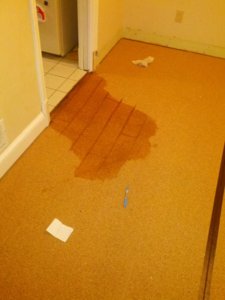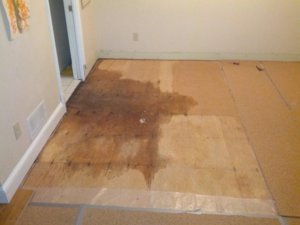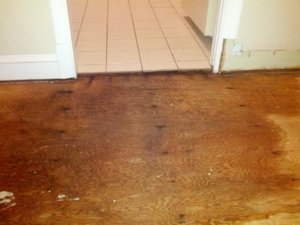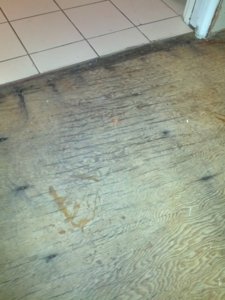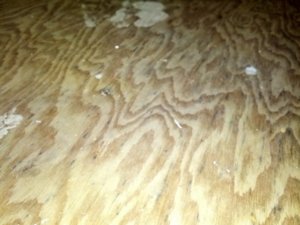RatLabGuy
You look like a monkey and smell like one too
- Joined
- May 18, 2005
- Location
- Churchville, MD
This evening I discovered that somewhere along the water line into my fridge/freezer has been leaking. Haven't found the exact culprit but I suspect the inlet to the in-line filter I added beside the fridge (a year ago). Anyhow, it seems water was leaking down along the line, back behind the fridge, down through the hole in the floor, and from there spreading out under the floor. All I know for sure is I cut off the supply to that line and the dripping stopped.
Discovered this b/c I went downstairs into the basement and there was water dripping from the ceiling
 . Luckily, I'm a slacker and still haven't finished finishing my basement and haven't put in the ceiling yet so I can see everything. I don't know but I'd guess this had been going for about a day, two days at most.
. Luckily, I'm a slacker and still haven't finished finishing my basement and haven't put in the ceiling yet so I can see everything. I don't know but I'd guess this had been going for about a day, two days at most.
The kitchen is tile, but the fridge is in a corner right beside a door going to the living room... which has a thick 12mm laminate floor w/ cork underlayment. From up top, it looks really minimal - tile isn't wet, but the baseboards were, and the first 3ish laminate boards right there beside the fridge area are already cupping.
However, when I look up from underneath.... looks much worse. Most of the joists under the living room have water showing at the top where the joists meet the subfloor. On every row, the water in the subfloor looks like it uis originating from teh top of the joists and spreading outward, e.g. no big areas, just lines with jagged outcroppings as it spreads out along the subfloor wood. But it's enough that there are several places it was literally dripping down along the joists vertically, or along the bridging then onto the slab basement floor.
I'm guessing that it is running along the subfloor, perhaps underneath the plastic sheathing that is below the cork, or (hopefuly not) has made it above the cork and passing it along below the laminate. It then goes down the nail holes into the joist.
So I'm assuming that, ASAP I need to pull up the whole floor to dry it out from above? E.g. take out all the laminate, pull up the cork, remove the plastic, and run a dehumidifier for awhile, then put back down whatever is salvagable (or new floor). Is that right? Meanwhile I'm already running a dehumidifier downstairs to get up whats on the slab, and start drying out the joists/subfloor from underneath.
Lets say I get it all pulled out by, say, next weekend, am I OK not worrying about long-term damage to the subfloor and joists? I'm assuming it takes a good amount of time before rot/mildew etc start to set in?
The X-factor here is the cork underlayment. My understanding is it does not absorb water, and it also not prone to molding etc. So it may be protecting the flooring. However the water has to go somewhere, and I don't know if that means it will just be trapped on top of the subfloor.
Discovered this b/c I went downstairs into the basement and there was water dripping from the ceiling

The kitchen is tile, but the fridge is in a corner right beside a door going to the living room... which has a thick 12mm laminate floor w/ cork underlayment. From up top, it looks really minimal - tile isn't wet, but the baseboards were, and the first 3ish laminate boards right there beside the fridge area are already cupping.
However, when I look up from underneath.... looks much worse. Most of the joists under the living room have water showing at the top where the joists meet the subfloor. On every row, the water in the subfloor looks like it uis originating from teh top of the joists and spreading outward, e.g. no big areas, just lines with jagged outcroppings as it spreads out along the subfloor wood. But it's enough that there are several places it was literally dripping down along the joists vertically, or along the bridging then onto the slab basement floor.
I'm guessing that it is running along the subfloor, perhaps underneath the plastic sheathing that is below the cork, or (hopefuly not) has made it above the cork and passing it along below the laminate. It then goes down the nail holes into the joist.
So I'm assuming that, ASAP I need to pull up the whole floor to dry it out from above? E.g. take out all the laminate, pull up the cork, remove the plastic, and run a dehumidifier for awhile, then put back down whatever is salvagable (or new floor). Is that right? Meanwhile I'm already running a dehumidifier downstairs to get up whats on the slab, and start drying out the joists/subfloor from underneath.
Lets say I get it all pulled out by, say, next weekend, am I OK not worrying about long-term damage to the subfloor and joists? I'm assuming it takes a good amount of time before rot/mildew etc start to set in?
The X-factor here is the cork underlayment. My understanding is it does not absorb water, and it also not prone to molding etc. So it may be protecting the flooring. However the water has to go somewhere, and I don't know if that means it will just be trapped on top of the subfloor.
Last edited:


